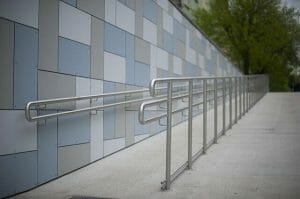Wheelchair ramps are inclined surfaces that connect different levels, making these levels accessible to wheelchair users.
In the last decade, growing awareness about increasing access for the disabled and wheelchair users has gone a long way in ensuring that public spaces and buildings are made wheelchair-friendly.
In this article, we answer the question, how wide is a wheelchair ramp.
Contents
Wheelchair Ramp Width

Temporary wheelchair ramps are between 15 and 36 inches wide. Permanent wheelchair ramps should be 75 inches wide to allow 2 wheelchairs to pass abreast in opposite directions.
Across the world, construction best practices which facilitate wheelchair access have been drafted and measures have been put in place for their strict adherence in all new constructions.
There is a growing awareness about making new buildings more accessible to everyone. Wherever possible, old constructions have also been altered or tweaked to allow easy wheelchair access to larger parts of public and private infrastructure.
Organizations Enforcing Accessibility Guidelines
In North America, especially the US and Canada, two organizations are responsible for drafting and enforcing the regulations related to increasing accessibility for wheelchair users and disabled.
In the US, the U.S. Equal Employment Opportunity Commission is responsible for drafting and enforcing the Americans with Disabilities Act (ADA), which became law in 1990.
In Canada, the Council of Federal Accessibility Agencies (CFAA) is responsible for enforcing the Accessible Canada Act (ACA, became legislation in 2019), which builds on the more generic Canadian Human Rights Act.
At a more provincial level in Canada, for example in Ontario, the Accessibility for Ontarians with Disabilities Act (AODA, which became law in 2005) dictates standards and specifications for increasing accessibility for the disabled and wheelchair users.
The standards set by these guidelines are continuously evolving as per the changing social, business and economic scenarios. These guidelines are also responsible for setting and enforcing wheelchair ramp guidelines and compliance.
Further, the requirements vary between different states in the US and also between provinces within Canada.
So how wide is a wheelchair ramp?
Click here to read our article on the Best Lightweight Transport Wheelchairs
Wheelchair Ramp Width Guidelines
Ramp width guidelines are extremely important as they stipulate standard minimum ramp width requirements. When implemented, it will allow wheelchair users to comfortably and safely maneuver their device on the wheelchair ramp .
Standardized ramp widths will also help users to get quickly acquainted with ramp paths across different public infrastructure systems. While the minimum ramp width is specified in all cases, some guidelines also stipulate a maximum ramp width.
The maximum width guideline generally allows only a certain width between two hand railings, as hand railings are expected to provide support to wheelchair users if the need be. Ramp width guidelines vary greatly, depending on the state or province or the type and installation of the ramp.
For example, as per ADA guidelines, a wheelchair ramp has to have a minimum width of 36 inches. However, the states of Massachusetts and California in the US have specified minimum ramp width requirements of 48 inches in order to be compliant with ADA guidelines.

Depending on the amount of traffic through a ramp or if you anticipate two-way traffic, ramp installers may decide to use a wider ramp, so that there is enough space for two wheelchairs to comfortably cross from either side.
Given that the standard wheelchair width is around 28 inches, this would require the installation of a ramp of a minimum width of about 70 – 75 inches, ideally with the provision of handrails in between.
As another example, as per the Accessibility for Ontarians Disabilities Act, a ramp should at least have a width of 900 mm (roughly 35 inches) to be compliant with the guidelines.
Further, when the ramp width is greater than 2,200 mm or 86.6 inches, hand railings are stipulated to be installed on the ramp, for the entire distance of ramp between any two landings.
The hand railings should be placed so that there is no more than 1,650 mm or 65 inches between any two handrails. This stipulation is akin to specifying a maximum width as well, which is done so that the wheelchair user can use handrails for support while maneuvering the device.
The British Columbia Building Access (BCBA) guidelines stipulate the minimum width of a ramp as clear space of at least 1,500 mm or 59 inches, if it is a single ramp. If there are two adjacent ramps, each of the ramps should be at least 915 mm wide between hand railings.
Many major cities accept the state or provincial level guidelines and further improve on them to enhance accessibility. For example, the City of Ottawa Accessibility Design Standards (COADS) stipulates a minimum ramp width of 1,100 mm or about 43 inches, sharply higher than that stipulated by AODA.
Similarly, the City of Toronto Accessibility Design Guidelines (CTADG) says that ramps should be between 1,100 mm and 1,015 mm wide (between 43 and 40 inches) to allow wheelchair users to move comfortably and also to be able to grasp the hand railings if required.
Width guidelines with such tight ranges often lead to greater standardization of accessibility infrastructure.
CTADG further specifies that where the ramp is specifically designed for users with vision impairment, the width should be at least 1,525 mm or 60 inches to allow extra room for a companion or a dog to walk on the side.
Guidelines for accessible street design in Canada stipulate that curb ramps be constructed at all street corners with minimum width of 900 mm or about 36 inches.
You may also like Best Bariatric Power Wheelchair
Ramp Landings
An integral part of ramps is ramp landings. There are at least 2 landings for a ramp, the top and bottom ones. There may be more landings placed intermediately through the ramp, depending on the total length of the ramp and the type of installation.
As per the AODA, ramp landings should be guided by the following stipulations:
- Landings must be present at a minimum at the top and bottom of a ramp, at the place of any sharp change in ramp direction and also at intermediate points not separated by more than 9,000 mm or 9 meters
- Landings must be of minimum dimensions of 1,670 mm by 1,670 mm or about 66 inches by 66 inches
- Change in level or slope of greater than 1 : 50 is not permitted, that is, it has to be more or less a flat surface
The BCBA stipulates minimum landing space length of 1,500 mm or about 59 inches.
Landing specifications stipulated by the ADA are slightly different. While the guidelines for landing locations within the ramp are the same, the differences exist in:
- Change of level or slope of greater than 1 : 48 is not permitted in a landing and it should be constructed in a way that there is no water logging (especially, since a landing area always follows a sloped ramp).
- Landings must be of minimum dimensions of 60 inches by 60 inches. Handrails, edge protection features or anything else is not allowed to encroach within this 60 x 60 inches free space
Some guidelines like those provided by the COADS also specify that whenever a landing space leads to a door, the landing needs to be extended further to allow for maneuvers required by wheelchair users. In the event where the door is opening towards the ramp landing, the landing space should be extended by a minimum of 600 mm or about 24 inches. Otherwise, if the door is opening away from the ramp landing, the landing space should be extended by at least 300 mm or about 12 inches.
Landing areas are also required to be heated to prevent accumulation of snow and ice formation to prevent hazardous slippery conditions.
As a best practice measure, the COADS says that provided there is availability of space, ramp landings should occupy spaces of 2,250 mm by 2,250 mm or about 89 inches by 89 inches. This is to accommodate power wheelchairs or mobility scooters which may require more space for braking when compared to manual wheelchairs.
The video below shows some tips on choosing wheelchair ramps.
Foldable or Portable Ramps
Portable ramps are available for personal use at homes and they are not governed by the guidelines mentioned above. These ramps are typically shorter in length, anywhere between 48 inches to 108 inches. They are also less wide. Width typically ranges between 26 – 36 inches.
If you are interested in knowing more about these, read our review of best portable wheelchair ramps.

You may also like Best Mid Wheel Drive Wheelchairs
Conclusion – How Wide is a Wheelchair Ramp?
While the guidelines specify the minimum dimensions with respect to ramp and ramp landings, it is best that you install a slightly larger ramp, in order to accommodate for higher traffic than which is normally anticipated and peak level traffic.
It is also a best practice to build generous landing spaces into ramps, to facilitate electric mobility aides which may take a longer space to slow down and stop. It has to be remembered that it is a one time investment. It has been seen that better adherence to accessibility measures often result in better business potential.
If you are looking for more wheelchair accessories, you can read our articles on best seat belts for wheelchairs, best bags for wheelchairs and walkers, and best gloves for wheelchair users.
Other Ramp Related Guidelines
A ramp has strict guidelines related not only to width, but also related to hand railings, edge protection, ramp guards or railings, height of the ramp, height to length ratio (ramp slope) and also landing spaces. The complete ramp guidelines, as laid down by ADA, AODA, COADS and CTADG may be found at the following links respectively:
AODA: https://www.ontario.ca/laws/regulation/r12413
COADS: https://documents.ottawa.ca/sites/documents/files/documents/accessibility_design_standards_en.pdf
CTADG: https://www.toronto.ca/wp-content/uploads/2017/08/8fcf-accessibility_design_guidelines.pdf
